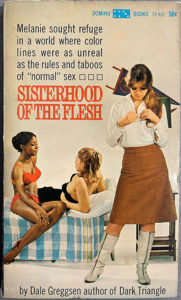Winning the 2021 James D. Forbes Collecting Prize
In Spring 2020 I submitted an entry to the J.D. Forbes competition. My entry, loosely based on my PhD research, was titled From Salt to Satan: An introduction to a collection of “lesbian pulp” as cultural items. What seemed an age later, in February 2022, I stepped up to receive the winner’s certificate from Principal Sally Mapstone, in front of an invited audience in the Laurence Levy Studio of the Byre Theatre in St Andrews.

A lot had happened in between. For a start, Covid-19 had forced lockdown upon us, and the 2020 competition had been cancelled. Fortunately, entries from 2020 were carried forward to the 2021 competition, so I had a second life, as it were. The competition interview took place, under lockdown conditions, over MS Teams, and I sat at home, my desk overflowing with ephemeral paperbacks from the 1950s and 1960s, fielding questions from an august panel. I had to convince them that here was a harvestable commodity worthy of a serious collection.
I succeeded, and in Autumn 2021 I was informed that I had gained the laurels. I was very pleased for myself, but also that I had achieved recognition for a little-regarded sub-genre within a mass literacy event of mid-20 century USA. The culmination came on that early evening in February when, having received the winner’s certificate, I had to speak at the Byre, off-the-cuff, about my books.

What to say? Well, as it happened, Dr William Zachs, eminent collector of books and founder of the J.D. Forbes Collecting Prize, had just spoken about his own collection, and had shown us a new acquisition, which contained a gathering from the Aberdeen Breviary, c1510. He had spoken about the questions most commonly asked of him – “what is your most valuable book?”, “what is your favourite book from your collection?”, “have you read all the books you have collected?” and “what book would you most like to add to your collection?” Although I would step, as my late father put it, “from the sublime to the blimey,” as I introduced the audience to items not designed to be an expression of the eternal, but rather to be sold cheap, disposed of, and forgotten, I figured that for this blog I could do the same as Dr Zachs.

What is my most expensive book? As it happens, the title of my winning essay, From Salt to Satan, gives a clue. In 1953, Claire Morgan’s The Price of Salt had a cover price of 35¢ US; in 1966 Fred Haley’s Satan was a Lesbian had a cover price of 95¢. These days a collector could expect to pay a sum in at least three figures for either – that’s dollars or pounds! This has nothing to do with literary merit, as those two books mark the zenith and nadir of narrative skill and style in lesbian-themed paperbacks. It has to do with rarity. Claire Morgan is better known as Patricia Highsmith, of Mr Ripley fame, and The Price of Salt is now better known as Carol, republished, re-attributed, and reimagined as a major movie. Fred Haley is a virtually unknown author, but his Satan was a Lesbian is loved by collectors for its engagingly awful cover art!

What is my favourite book? Bill Zach’s answer was “the most newly-arrived”. I know what he means, but in my case the answer is stranger: “I can’t remember!” All I know is that if I thumb through my collection I will find one which has, on its flyleaf, the rubber stamp of the local shop where it was originally sold. Google Maps will take me right to the place where that store was located. When considering books as more than text – as cultural objects – there is something thrilling about pinning them down in space.
That book – give me half an hour and I’ll find it – is one I treasure for that little commercial link. The books I enjoy reading most are those which form a major part of my research material, and were written by Ann Bannon. Ann, who went from being a typical 1950s American housewife, to being an author with a substantial underground following, and eventually to become a Professor of Linguistics, is still with us, and I have been in regular contact with her over the past few years. Her kindness has helped both my research and my collecting. I treasure my original copy of her novel The Marriage too, because when I opened it I found that at some time in the past she must have autographed it for a fan.

Have I read all my books? Test me on them!

What book would I most like to add to my collection? I will name two, both by author Rea Michaels. Before and during my talk, I pointed out to visitors the fact that this literature has a cast of characters that is almost exclusively white. The milieu in which these books were sold had a footfall of middle-class and working commuters, and they were aimed at a mainly white readership. Very few principal characters were anything other than European-American. Authors such as Arthur Adlon and Dale Greggsen occasionally included characters of colour in their novels, but How Dark My Love and Duet in Darkness by Rea Michaels are outstanding in their portrayal of lesbian love across a racial divide. They are sensationalised for their market, but they are part of this sub-genre which I would like to research in greater depth.
I am honoured to have received the 2021 J.D. Forbes Collecting Prize, and delighted to have had this chance to share some of my collection with you. If you would like to know more, please do not hesitate to get in touch with me ([email protected]).
Paul Thompson
PhD Candidate, School of English
(photos of the Collecting Prize event: Gayle McIntyre)